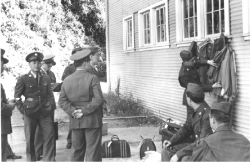Presidio museum to honor Japanese-Americans who served in World War II secret intelligence program

outside Building 640 Photos: Presidio Trust
In November 1941, one month before the bombing of Pearl Harbor, Gene was informed that he was now part of the Military Intelligence Service (MIS) a top-secret program headquartered in Building 640 at the Presidio of San Francisco. Gene, and later Marvin, eventually became teachers in the program.
Since Building 640 was the first headquarters for MIS, the National Japanese American Historical Society (NJAHS) is in the process of creating a museum to honor the 6,000 graduates of the MIS program. Building 640 might have been permanent headquarters except for government orders to move and incarcerate 120,000 Japanese-Americans from the West Coast. So the teaching center moved to Camp Savage and Fort Snelling in Minnesota.

Building 640 during World War II
Located across from West Crissy Field, the 10,000-square-foot building was headquarters for only one MIS Language School class. But according to materials provided by the NJAHS, that one class was the impetus for what followed, including the famous Defense Language Institute at the Presidio of Monterey.
In 1991, the 50th anniversary of MIS, NJAHS advocated the preservation of Building 640 for those who served secretly in the MIS. In 2002, NJAHS entered into a partnership with the Golden Gate National Recreation Area, the National Park Service, and the Presidio Trust. The organizations conducted studies to determine the feasibility of rehabilitating the building. Today, the groups are co-sponsoring the building of the museum.
Gene and Marvin are Nisei, or American-born children of Japanese immigrants. In the spring of 1942, while Gene was serving his country, Marvin and his family were escorted to Tule Lake, one of the World War II relocation camps. Luckier than many, the Uratsu family entrusted the care of their Loomis, Calif. farm to a Caucasian family. Many Nisei were stripped of all assets so that they had nothing left at the end of the war.
Asa Hanamoto, a colleague of Marvin Uratsu in the MIS, chuckles today with irony about the stated rationale to remove the Nisei from their West Coast homes. “We were told that this was for our protection, but the guns were all pointed inside,” he said.
Since no Japanese were allowed to be on the West Coast after the spring of 1942, the Uratsu family moved to several camps, and Marvin was allowed to “go outside” to finish high school in Des Moines, Iowa. He then wrote a letter requesting to join the Army as he did not want to be drafted. Desperate for linguists, an Army colonel asked him to write a letter in Japanese, after which Marvin found himself in the MIS. The year was 1945, so Marvin was readied to aid in the occupation of Japan.
Hanamoto credits General Douglas MacArthur with the acceptance of this by the Japanese people. “MacArthur let the emperor surrender with dignity, and I think that helped his people accept us,” he said.
Tom Sakamoto, who was present at the surrender ceremony and who calls it one of the most emotional moments of his life, thinks it was because the emperor told his subjects: ‘We lost. Act subservient to the victors.”
Perhaps it was a little of both.
“What we did during the occupation led to the relationship we have today with Japan,” said Uratsu.
While Hanamoto and Marvin Uratsu served primarily during the occupation, Tom Sakamoto worked with the MIS program during the war.
Clearly, the U.S. Army was not prepared to deal with the enemy in a noncombat situation. Army personnel scouted the relocation camps all over the country looking for Nisei who were able to translate documents, diaries and journals and to conduct interrogation of captured troops.
Although the MIS was top secret during the war, many feel no qualms today about discussing their experiences.
“The camp was terrible,” Hanamoto said. “Some of those incarcerated accepted our fate, but others were angry and bitter. In order to join the Army, for example, the Nisei, American citizens, were forced to sign a loyalty oath. Sometimes physical fights broke out and I think there were some who were killed.” Hanamoto would do practically anything to get out of the camp, and while he worried about his family, he viewed the Army’s MIS program as the best way for him to leave.
After training, Hanamoto and Uratsu went first to the Philippines near the end of the war and then to Tokyo as part of the Occupational Forces. They were surprised at the lack of hostility among the Japanese citizens toward the Nisei.
Sakamoto’s family was sent to a camp in Arkansas. “This was a really tough time,” he said.
Sakamoto eventually volunteered for combat and was able to retrieve written materials and information from prisoners he interrogated. He went on to serve in Korea and Vietnam, earning the rank of colonel when he was discharged.
But it took more than one war for the U.S. Army to reward Japanese-Americans for their service: 6,000 Japanese-Americans from the MIS program graduated with the rank of Tech Sergeant; Caucasian Americans were given the rank of Second Lieutenant.
All of the men were enthusiastic about the creation of the museum in the Presidio’s Building 640.
“The Military Intelligence Service Historic Learning Center will demonstrate that whether the MIS members were studying at a desk, crawling through caves, or supporting code-breaking efforts, they need not remain a secret 65 years later,” said Francis Wong, director of development for the NJAHS.
“We aren’t trying to glorify the war but honor those who served,” said Tom Sakamoto.
For more information about the museum, visit www.njahs.org or call 415-921-5007.


